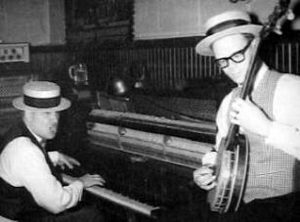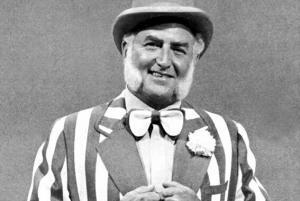Italian-Americans were instrumental in the creation of jazz: Nick LaRocca. Leon Roppolo. Joe Venuti. Louis Prima. When he was born, Eddie Lang was named Salvatore Massaro.
Maybe it was the Italian connection to classic jazz that inspired the confluence of Dixieland and pizza parlors in the 1950s. And the fact is that jazz—like pizza—may have some Italian origins but came to fruition as a wholly American convention.
While early versions of pizza were developed centuries ago in Naples, the baked dough doused in tomato sauce and melted cheese actually began its climb up the ladder of popular cuisines when Neapolitan immigrants established pizzerias such as Lombardi’s in lower Manhattan, opened in 1905.
At the same time, jazz was being born in old New Orleans.
In the first half of the 20th century, pizzerias did brisk business in major American cities such as Philadelphia and Chicago. After World War II the rest of the country caught on and by the mid-1950s the hot sliced pies took the food business by storm worldwide.
During that decade traditional jazz enjoyed one of its periodic revivals, this one largely spawned by West Coast cats such as Turk Murphy and Lu Watters.
“Shakey” Johnson

So along comes a colorful character named Sherwood “Shakey” Johnson—a U.S. Navy veteran of the Pacific Theater and a lackadaisical law student from Sacramento, California—who had become a big fan of Watters, the trumpet-blowing leader of the Yerba Buena Jazz Band. After making a splash in San Francisco, in 1950 Watters relocated his band to The Hambone, his own club in El Cerrito, about 70 miles southwest of Sacramento.
Anyhow, in April 1954 at age 29, Shakey Johnson—who acquired his nickname after a bout with malaria left him a little jittery—partnered with his fishing buddy, Big Ed Plummer, and opened the original Shakey’s Pizza Restaurant & Ye Public House. They installed beer taps and brick ovens inside a remodeled corner grocery store at 57th and J streets in East Sacramento, and flung open their doors to a pizza-hungry public.
Shakey and Big Ed served their mozzarella pies with a satisfying side-order of Dixieland jazz all washed down with rivers of bubbly lager or black Bavarian beer. At night they projected silent flickers on the wall featuring slapstick comedians such as Laurel and Hardy.
Employees wore red-and-white-striped shirts, straw hats, and string ties. Clever signs adorned the walls and tabletops. One reminded customers, “You can feed your face at any old place, but you can warm your heart at Shakey’s.”
Live Music
The original joint staged live music nightly and Shakey—a passable piano plunker himself— insisted on jazz-oriented fare, preferably New Orleans-style. Shakey pounded out ragtime piano tunes and boogie woogie, but in 1955 he hired the Silver Dollar Jazz Band, a swingin’ sextet of musicians who first played together in 1949 at Sacramento High School.
Trombonist Burt Wilson snagged the job for the band. After graduating from University of Southern California and while awaiting a call from the U.S. Army, Wilson was bartending at Shakey’s and asked the owner if he could hire his old high-school pals to play. Shakey told him to go ahead, “As long as it sounds like Lu Watters.”
Although forged in the Watters mold—notably employing two banjos, Don Van Palt and John Robinson—the Silver Dollar outfit had no regular trumpeter.
Nevertheless, clarinetist Phil Howe remembered that Shakey initially paid the band $5 per man (another insists it was $10 each), “and all the beer and pizza we wanted.” After the six musicians liberally slaked their hunger and thirst at Shakey’s expense, the bossman restructured his payment plan.
“He found out later it was costing him more money to do that than if he paid us scale. So he decided to pay us scale which was cheaper for him, and we had to pay for our booze after that,” Howe said with a smile.
At whatever price, the Silver Dollar Jazz Band was a worthy investment. “It caused a sensation,” said Wilson, who went on to write a book called Shakey & Me (Paloria Press, 2001).
Banjo man John Robinson said Shakey actively aided and abetted the restaurant’s festive ambiance. “Shakey was a character, and we loved him, and he loved our music,” Robinson remembered. “At least once a night he’d call out, ‘Come on guys. Play the Tiger Rag.’”
Something Bigger
Once in a while, things might get a little out of hand like the night the band got “a little stiff in there,” according to reed player Dutch Deutsch, “and we started throwing beer glasses into the fireplace, imitating old Errol Flynn movies.”
It was all in good fun, but the band became part of something much bigger than itself.
Pianist Sugar Willie Erickson attests to its import: “Sure, I played two-beat the best I could, but then something happened like a light coming on and it has stayed with me ever since. It was like a revelation. I didn’t really have a purpose before that, a real purpose to live for, but I found God with the Silver Dollar Jazz Band.”
While Erickson found metaphysical meaning in the music, the greater Sacramento community found itself enlivened by the syncopated sounds of the Silver Dollar combo. Classic jazz had found a new home in the Golden State’s capital city.
Sac Jazz
Jazz historian K.O. Eckland, author of the book Jazz West: 1945-1985, credits the Silver Dollar sextet for igniting the Sacramento jazz revival that extended to the formation of the Sacramento Traditional Jazz Society in 1968 which, in turn, founded the world-famous Jazz Jubilee (now known as the Sacramento Music Festival). Shakey’s also became known outside Sacramento, not for its pizza, but for a jazz program it sponsored on a regional radio network.
In 1966, Shakey Johnson sold his half of the company for $3 million to Colorado Milling and Elevator Co. which acquired Big Ed Plummer’s half for $9 million the following year. By 1967, there were 272 Shakey’s Pizza Parlors in the United States, and the franchise soon expanded into Canada, Japan and the Philippines.
He may have been out of the pizza biz, but Shakey remained a beloved figure among the classic jazz cognoscenti. He was named Emperor of Jazz at the first Jazz Jubilee in Sacramento in 1974, and was inducted into the Banjo Hall of Fame in Guthrie, Oklahoma, for regularly booking banjo music at his pizza parlors.
After Hours
Shakey retired to a ranch house he built on a 105-acre estate in Oregon House, California, before dying of a heart attack on Halloween 1998, at age 73.
 In his younger days, Shakey could often be seen wearing a black derby, smoking a stogie, and sipping a schooner of suds. In later years, he sported a well-trimmed set of white muttonchop sideburns.
In his younger days, Shakey could often be seen wearing a black derby, smoking a stogie, and sipping a schooner of suds. In later years, he sported a well-trimmed set of white muttonchop sideburns.
He appeared with the Silver Dollar Jazz Band at a few reunions in the 1980s and ’90s, and the sextet created quite a stir playing at the Jazz Jubilees of 2001 and 2005. At the 2005 reunion, the band still featured Wilson, Erickson, Van Palt, and Robinson joined by trumpeter Renard Perry, clarinetist Bob Newman, drummer Jim Lukas, and tuba player Jim Snoke. They closed their performance that day with “Shake That Thing,” the ever-catchy stomper by Papa Charlie Jackson from 1925.
The East Sacramento Shakey’s location closed after a 1996 fire but went on to house several restaurants, most recently Mimosa House.
By 1997—after the Shakey’s franchise had changed hands from the Colorado Milling and Elevator Co. to the Hunt International to Inno-Pacific Holdings—the brand had evolved into a fast-food franchise, and live music was no longer on the menu. In 2003, the company began “re-engineering” its brand as a family-oriented casual dining place.
Now a well-established franchise in the Philippines, Shakey’s—currently owned by the Jacmar Companies of Alhambra, California—has about 500 stores globally, and about 60 in the United States. There are about 50 Shakey’s Pizza restaurants in the United States—46 in California, all in the southern part of the state except for one in Oroville, a Butte County town about an hour north of Sacramento. The rest are located in Alabama, Hawaii, and two in the state of Washington.
Paying Tribute
So for most of America, Shakey’s is just a fond albeit hazy memory. In Sacramento, however, it’s still a shrine. The city’s up-and-coming classic jazz quintet known as the Crescent Katz pay tribute to Shakey’s at least twice a year year—at festivals in nearby Monterey and Pismo Beach—by donning cheesy red-and-white-striped vests and performing tunes such as “Has Anybody Seen My Gal?” “Cake Walkin’ Babies from Home,” and a swinging “Take Me Out to the Ballgame.”
Led by trombonist Brandon Au, the Katz include banjoman Greg Sabin, hot trumpeter Jeff Kreis, tuba player Priscilla Ornelas, and washboard player Patrick Skiffington, who’s a big fan of the Silver Dollar outfit.
“The real story about SDJB is that because Shakey loved traditional jazz so much, when other stores and franchises opened they would employ local musicians that played in that style,” Skiffington said. “It created a demand for players. Many Shakey’s alumni from coast-to-coast went on to be quite famous in their own right.”
A few years ago, the Crescent Katz jammed with Burt Wilson at the original Shakey’s location before he hung up his horn for good. “It was a huge honor for us to play with the Godfather of Pizza Jazz,” Skiffington said.
Two years ago, the Katz played the 40th anniversary party for the last Shakey’s Pizza Parlor operating in Northern California, in Oroville. “Now that Shakey’s is just like walking into the 1970s,” Skiffington said. “As a matter of fact, that is the only Shakey’s that we have been fortunate enough to have played at once, so far.” The Oroville shop is one of the few Shakey’s nationwide which still present live music, Skiffington said. “But sadly only twice a week, and they’re country and western bands, not jazz.”
On their 2015 CD, From Scratch, the Crescent Katz waxed a tune called “Go to Shakey’s.” Written by Burt Wilson and sung to the to the tune of “Pretty Baby”—Storyville pianist Tony Jackson’s perky composition circa 1910—the track showcases terrific trumpet and trombone leads by Kreis and Au, respectively, but it’s Skiffington’s carefree caterwauling over enthusiastic vocal support from all that really makes the tune memorable:
Buy yourself a pizza, have a bucket of beer.
Listen to the jazz band play.
So if you want to buy a pizza
and you don’t know where to go –
57th and J, 57th and J!
Russ Tarby is based in Syracuse NY and has written about jazz for The Syncopated Times, The Syracuse New Times, The Jazz Appreciation Society of Syracuse (JASS) JazzFax Newsletter, and several other publications.






















